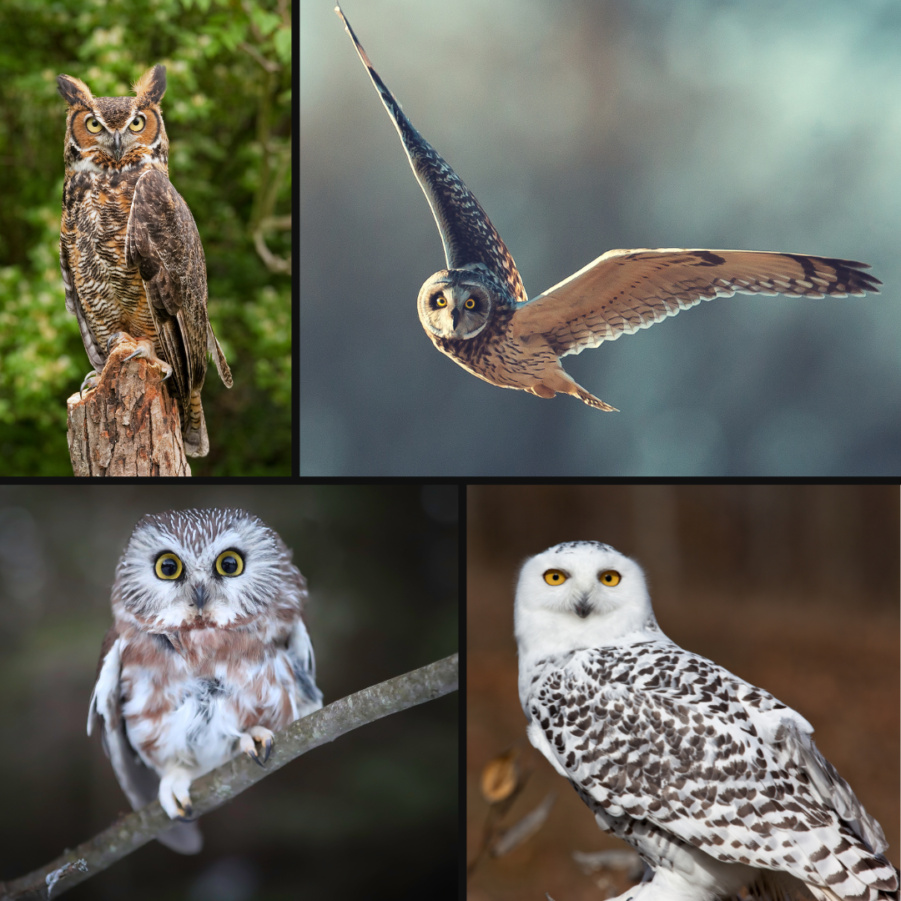While I get frequent requests for bird posts, one group of birds has recently been the top. Owls are a fascinating and in some ways mysterious group of raptors that has captured peoples’ cultural imagination for millennia. It’s about time we covered these neat animals on Gulo in Nature! So in this Wildlife Spotlight post, let’s learn some fascinating owl facts to get to know these unusual birds.
Now, on to the owl facts!
1.Owls belong to their own order: Strigiformes

Unlike many other groups of plants and animals that share a common name, owls are in fact a closely related group. These birds all belong to the order Strigiformes, and thus share a common ancestor. Of the nearly 10,000 bird species on Earth, around 200 of these are owls. These fascinating animals can be divided up into two main families:
- The Strigidae, or “true owls”
- The Tytonidae, or barn owls.
While all of these are owls, the barn owls have some distinctive characteristics that set them apart from the rest. Owls are found nearly everywhere on the planet, with the exception of a few isolated islands, and the North and South poles.
Want to learn how to identify birds in your own back yard? Check out this guide!
2. They have weird feet
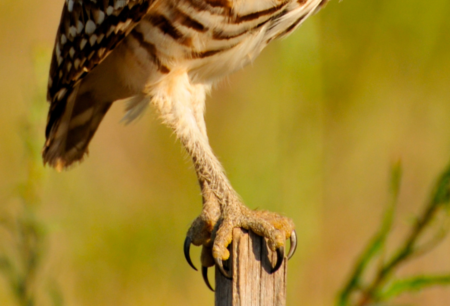
Owls have what are known as zygodactyl feet. This means that their four toes are arranged in an “X” pattern, with two up front and two behind. This is different than the normal anisodactyl pattern for birds, which has three toe sup front, and one in the back. Other species with zygodactyl feet include parrots, woodpeckers, and hoopoes (Upupa sp.).
Why do woodpeckers drum on my house?
3. Their ears are often lopsided
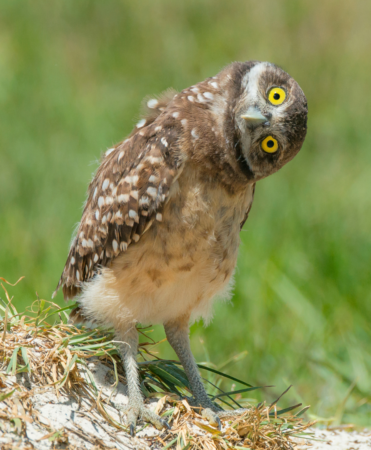
Here’s one of my favorite wild owl facts! Most species of owls have asymmetrical ears. In other words, the ears on each side of their heads are different, unlike our own. In their case, one ear is typically higher or lower than the other, making them lopsided. This strange adaptation helps owls better locate prey using their hearing. By cuing in on tiny differences in timing of the arrival of soundwaves to one ear versus the other, owls can discern the location of prey items. While the side-to-side distance of our own ears allows us humans to distinguish between sounds coming from left to right, this additional asymmetry lets owls tell sounds coming from above or below effectively as well.
4. Owls can fly in near total silence

As nocturnal hunters, owls rely on stealth to avoid detection by their prey. Animals like rodents and lagomorphs (rabbits and relatives), which are often major prey for owls, have excellent hearing. Because of this, owls need to be able to hunt and approach them while making little noise at all. That can be a challenge for a bird, since flying is often noisy business.
If you have never handled a bird before, that may come as a surprise. But bird’s wings move a lot of air around as they flap, and can make sounds that are very obvious for sensitive ears. To deal with this, owls have specially adapted feathers which dampen the noise made during flight. These include longer, fluffier barbs at the base of the feather and along the vane. In addition, the outer wingfeathers have a serrated pattern to break up the continuous airflow that makes flight noisy. The result? Whisper-quiet wings!
This is one of those owl facts I’ve had the pleasure of seeing first-hand. Some years ago I volunteered with the Owl Research Institute to help study Northern saw-whet owls (Aegolius acadicus) in Western Montana. I helped capture and tag a young female owl, and got to see the amazing soundproofing on her wing feathers (see above!). When I released her outside, she seemed to just evaporate into the night air. Despite all the flapping of her big, wide wings, I didn’t hear a single sound. It was almost ghostly!
5. Not all owls are nocturnal
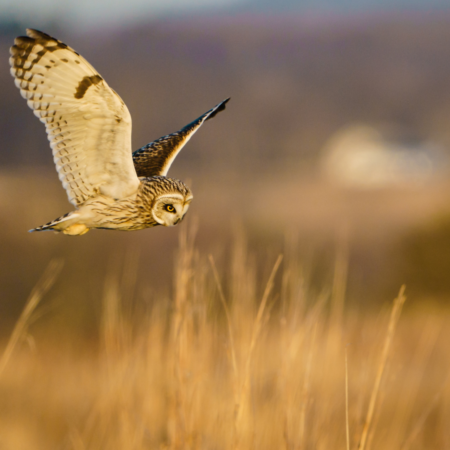
Yep, you read that right! In fact, there are some species of owls that are almost entirely diurnal (active during the day). While the vast majority of owls are active at night, some are excellent daytime hunters. Long-eared owls (Asio flammeus) and Northern hawk-owls (Surnia ulula) are two of the most diurnal owls in temperate regions. They tend to be slower fliers than hawks, so look out for their leisurely flapping if you’re birdwatching during the day.
Even species that typically active only at night can show up in the daytime. For instance, roosting owls can be disturbed by mobbing birds like blue jays or even by passing hikers, and you’ll catch a glimpse of them flying to a quieter location. These opportunistic sightings are a rare treat and are worth enjoying when you get them!
Check out these other birdwatching tips from Gulo in Nature
6. Their eyes can’t turn inside their sockets
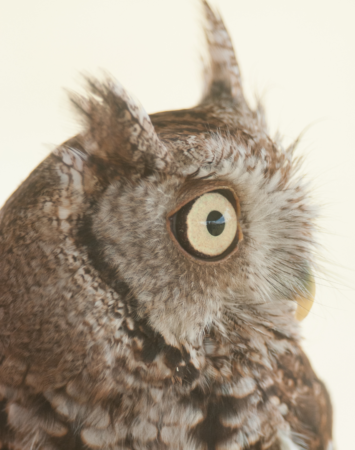
Most birds have a limited ability to move their eyes inside of their skulls like mammals do, and instead must turn their heads. Owls are an even more extreme case of this because their eyes face forward like ours do, giving a smaller range of vision. For example, just like humans, owls can’t see far out to the sides of their heads. In addition, owls have tube-shaped eyes, whose elongated structure gives them excellent night-vision. This special shape essentially locks them in place. As you’ll read below, owls have other adaptations to deal with that potential downside.
7. Bizarre “stilt-owls” once roamed Hawai’i on super-long legs!
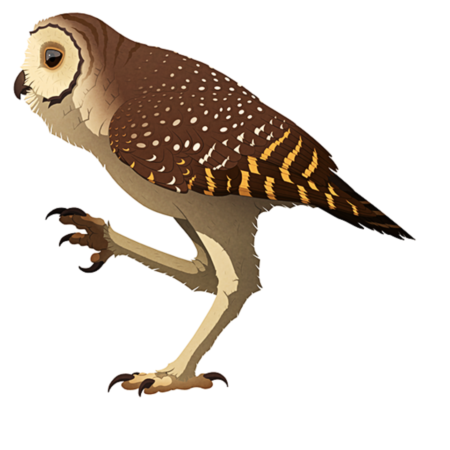
Here’s one of the least-known owl facts I typically share as a nature guide. Due to their geographic isolation in the middle of the Pacific ocean, the Hawaiian Islands host unique wildlife. Plants and animals on those islands have become adapted to uniquely different habitats and had little contact with the outside world. This led to this existence of some truly bizarre animals, chief among them the Hawaiian stilt owls (genus Grallistrix). These stilt-owls as their Latin name goes, are long-extinct owls that ran around on rather long legs.
Although they likely could still fly, Hawaiian stilt-owls probably hunted mostly on foot. Since there were no native rodents on the Hawaiian Islands most experts think that they hunted smaller birds. These probably included many of the Hawaiian honeycreepers, once a dominant group of animals on the islands. Based on fossil evidence, there were apparently unique species of Grallistrix on each of the main Hawaiian Islands.
8. Their heads work like radar dishes
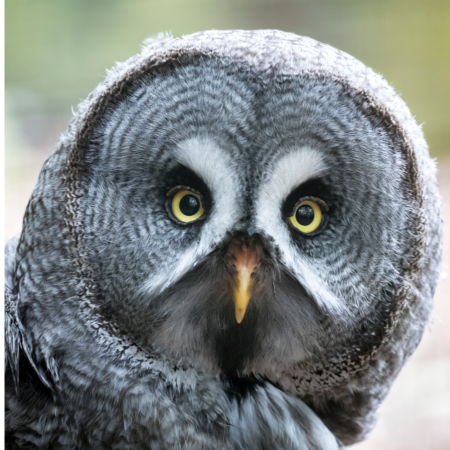
Although owls’ huge, forward-facing eyes and their tube-shaped structure gives these birds incredible night vision, it doesn’t hurt to have other superpowers. Unlike mammals (including humans!) which have external structures to concentrate sounds into our ears, birds have no visible external ear. The same way that cupping a hand around your ear can help you hear better, structures like that can make a big difference for hearing. Owls make up for a lack of external ears by having rings of feathers around their eyes called facial disks.
These disks concentrate sound much like our ears and help the owl with its directional hearing. Their satellite-dish shape is no coincidence: this shape helps an owl easily tell which direction a sound is coming from. If they point their head directly at the source, the volume of the sound becomes considerably louder in their perception.
9. Some owls live underground
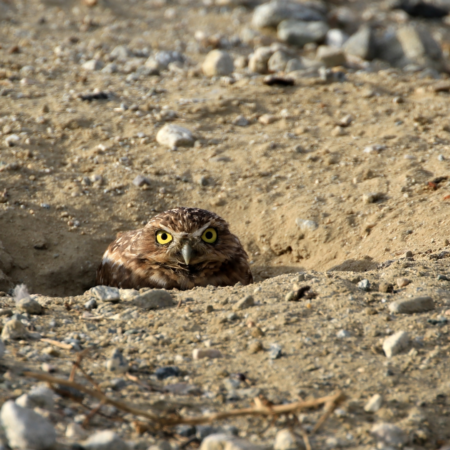
The burrowing owl (Athene cunicularia), found in North, South, and Central America is one of my go-to species for weird owl facts. These strange birds are relatives of the Little owl (Athene noctua), an aptly-named critter that is widespread in Europe, North Africa, and Asia. While burrowing owls themselves aren’t capable diggers, they live in tunnel systems made by other animals. In the American West, for example, they use whole networks excavated by prairie dogs (Cynomys sp.).
Burrowing owls are as cute as they sound; whole families of tiny owls running around underground. At night, they come up to feed and fly around open areas hunting small mammals and large insects as prey.
10. A group of owls is called a parliament
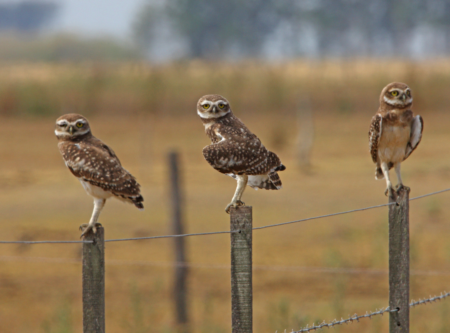
Apparently, owls were not spared the weird Victorian England craze of coming up with strange collective nouns for animals. Like a murder of crows or a gaggle of geese, owls have their own term. A group of owls, known as a parliament, is actually a rather rare thing most of the time. This is namely because owls are solitary hunters, even when they are paired up and raising young. You’re most likely to see a parliament when owls have fledged young that they’re caring for. More social species like burrowing owls may also be a good way to spot yourself a parliament!
11. They can rotate their heads further than other vertebrates
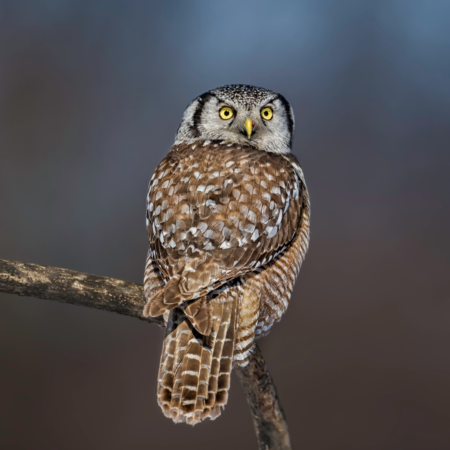
As we learned above, owls can’t move their eyes to look around. Furthermore, they have a rather narrow width of vision, just like humans, because their eyes face forward. To deal with this issue, owls have incredible neck mobility, and can turn their heads up to 270 degrees around! They have twice as many neck vertebrae as people do (14 versus 7!), and special adaptations to maintain bloodflow to their brains even when their neck is twisting around.
These include things like wider gaps in the vertebrae for major blood vessels to pass through, and the joining of multiple channels with an artery to allow a greater volume of blood to pass through. Without structural changes like these, owls can have their heads on a swivel without the risk of fainting.
12. The largest owls have a 6’3″ (~2m) wingspan!

When it comes to owl facts, people are always quick to ask me how big owls get. The answer is: big! The largest owl species may have individuals that weigh more than 10 lbs (4.5kg), a massive weight for a bird. The largest wingspan of any recorded owl was a female Blakiston’s fish owl (Ketupa blakistoni) with a wingspan that was 6’3″ (~1.9m)!
What bird has the largest wingspan?
With the exception of the aforementioned fish owls, most of the world’s biggest owls belong to the genus Bubo. These include the Eurasian eagle owl (Bubo bubo) and North America’s great-horned owl (Bubo virginianus). The latter has reached cultural icon status for its famous hooting sound, which is a universal sign of night in popular culture.
The 12 most common bird calls in movies and TV
13. Female owls are generally larger than males

Owls display what scientists call sexual dimorphism. This means that males and females will appear different, and have different physical characteristics. Just like many other raptors (for instance, hawks, falcons, and eagles), female owls are often bigger than males. There are many different hypotheses as to why this may be true. Most experts believe that it allows males and females to hunt different prey so that they aren’t competing with on another. It may also help male owls more quickly catch prey to bring to his mate while she is feeding young.
What’s the difference between hawks and eagles?
Looking for more cool owl facts? Check out this episode of The Nature Guys!
Thanks for checking out owl facts on Gulo in Nature!
If you enjoyed this post, please support the blog by sharing this post with friends and following the blog on Social Media. If you have a post that you’d love to see, get in touch using the Contact Page. Until next time, go get to know your natural world!

